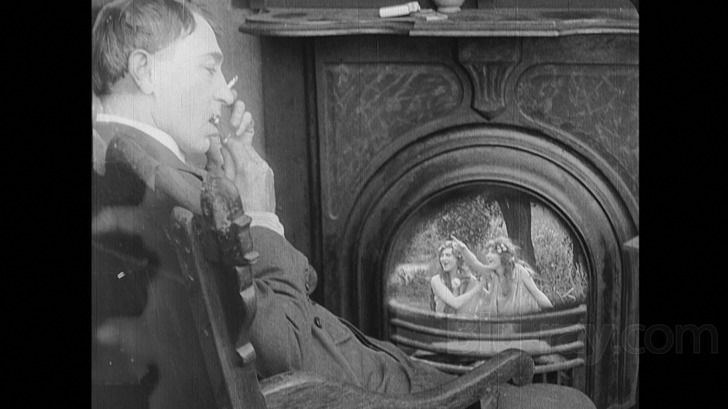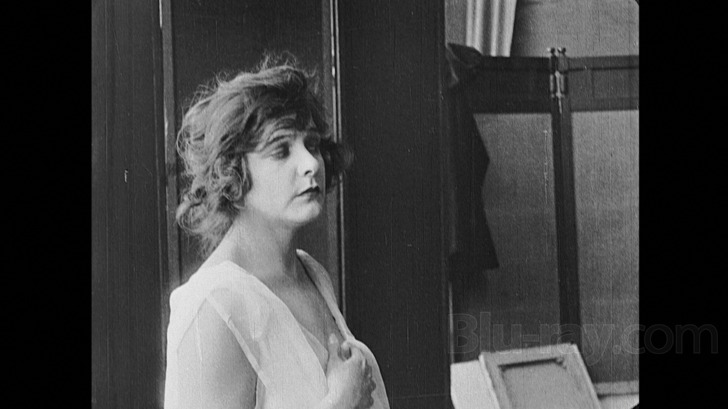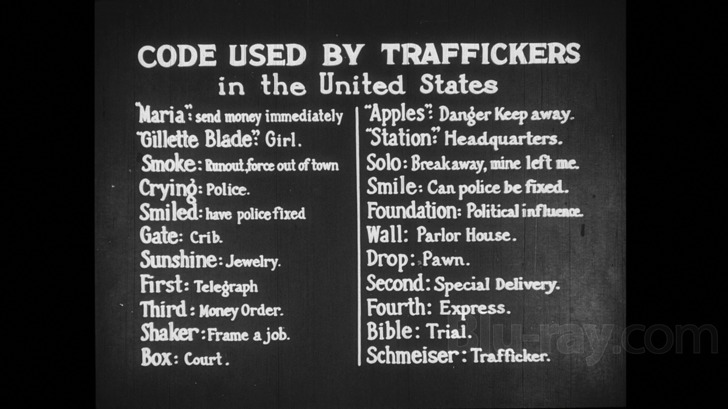The Devil's Needle and Other Tales of Vice and Redemption Blu-ray Movie
HomeThe Devil's Needle and Other Tales of Vice and Redemption Blu-ray Movie 
Kino ClassicsKino Lorber | 1913-1916 | 3 Movies | 167 min | Not rated | Jul 10, 2012

Movie rating
6.8 | / 10 |
Blu-ray rating
| Users | 0.0 | |
| Reviewer | 3.0 | |
| Overall | 3.0 |
Overview
The Devil's Needle and Other Tales of Vice and Redemption (1913-1916)
Includes: The Devil's Needle (1916, 66 min), Children of Eve (1915, 73 min + 8 min Outtakes), The Inside of White Slave Traffic (1913, Two Versions, 19 min & 28 min)
Starring: Norma Talmadge, Tully MarshallDirector: Frank Beal, John Collins (XX), Chester Withey
| Drama | 100% |
| Short | 33% |
| Crime | Insignificant |
Specifications
Video
Video codec: MPEG-4 AVC
Video resolution: 1080p
Aspect ratio: 1.34:1
Original aspect ratio: 1.33:1
Audio
English: LPCM 2.0
Subtitles
None
Discs
50GB Blu-ray Disc
Single disc (1 BD)
Packaging
Slipcover in original pressing
Playback
Region free
Review
Rating summary
| Movie | 3.0 | |
| Video | 3.0 | |
| Audio | 4.5 | |
| Extras | 0.0 | |
| Overall | 3.0 |
The Devil's Needle and Other Tales of Vice and Redemption Blu-ray Movie Review
Social ills in early cinema.
Reviewed by Casey Broadwater July 10, 2012The progressive-era, from roughly the turn of the 20th century to the start of World War I, found America in a state of flux. Industrialization and unionization. Political reform and the fight for women's suffrage. Science as the impetus of social progress and religious fervor as a catalyst for moral outrage. The rapid changes gave way to an unprecedented level of cultural self-criticism, with pundits and the public alike voicing opinions on issues that had been taboo or at least impolite conversation fodder during the more prudish Victorian times. Unsurprisingly, the cinema from the period also reflects this newfound openness about complicated urban problems. In The Devil's Needle and Other Tales of Vice and Redemption, Kino-Lorber has gathered together three films from the 1910s that look respectively at drug addiction, prostitution, and unsafe factory conditions. Lightly lurid for the times—but, it should be noted, exceptionally tame for ours—these might be thought of as proto-exploitation films, condemning the actions they depict but also giving audiences a mildly titillating thrill.

The Devil's Needle
The Devil's Needle (1916, 66 min.)
The collection draws its title from The Devil's Needle, an early Reefer Madness-style anti-doping drama—directed by D.W. Griffith protege Chet Withey—that was considered blasé even in its own time. The initial review in Variety said "everything in and about it is tame" and that it's "a very commonplace story and picture in these modern days." However commonplace it was then, it's significantly rarer now, seeing as how many of its cinematic predecessors have been lost to time. The value of the film, then—and of this collection as a whole—is primarily historical, standing as a visual record of then-contemporary social attitudes. You're certainly not going to get much out of the story, which is indeed rote, not to mention quaintly simplistic when it comes to its depiction of kicking the drug habit.
Screen legend Norma Talmadge (Smilin' Through) plays Renee Duprez, a fetching model and morphine addict who—when she finally drags herself out of bed—poses for John Minturn (Tully Marshall), an up-and-coming "artist of the modern school." Renee has a thing for the painter, and she convinces him to try smack, telling him that it "kindles the fire of genius." The film's two best scenes show Minturn under the effects of the drug, painting the hallucinated image of a model and succumbing to visions of two women frolicking in a meadow that appears inside his fireplace after he shoots up. The plot has its share of superficial histrionics, with Minturn falling for Patricia (Marguerite Marsh), the engaged daughter of a wealthy businessman, marrying her in secret, and then chasing her maniacally around the house, attempting to jab her with a hypodermic. The message isn't too different from today's—hard drugs will turn you into a crazy-eyed lunatic. (I was reminded of the recent "Miami Zombie" incident.) The finale features a daring rescue scene—Patricia is locked in a cellar by a dealer who suspects her of being an informant—and delivers the naively optimistic coda that anyone can break an addiction by following "Nature's own prescription, fresh air and hard work."
Children of Eve (1915, 73 min.)
Produced by Edison Studios and directed by John Collins—a promising filmmaker who died young of influenza—Children of Eve is one part call for industrial reform to two parts convoluted melodrama. A flashback prologue sets the scene; living in a flophouse, down-and-out businessman Henry Clay Madison (Robert Conness) falls in love with Flossie, the follies dancer in the adjoining room. She gets pregnant, but to save his reputation she runs away and dies shortly after childbirth, leaving her baby to be raised by another woman. Seventeen years later, Henry has become a rich and calloused capitalist, while his long-lost daughter, "Fifty-Fifty" Mamie (Viola Dana), is on her mother's path to ruin, dating a sketchy guy known as "Bernie the Gyp" and spending her time in a dancehall called The Bucket of Blood. By chance, Mamie meets Henry's adopted nephew Bert (Robert Walker), a left-leaning social worker nephew who's out to convince his uncle/father that industrial working conditions—especially for children—need to be improved. Bert falls in love with Mamie, naturally, and in his effort to reform her, he gives her a Bible and lands her a job as an undercover inspector at a canning factory with severe safety violations. The film is most notable for its literally fiery conclusion, which dramatically restages the real-life events of the 1911 Triangle Shirt Waist factory fire, which killed 146 workers. The sequence is impressively staged and surprisingly bleak—one shot even shows three children lying dead on the ground outside the inferno.
The Inside of the White Slave Traffic (1913, 28 min.)
The most fascinating film in the collection is unfortunately also the one most affected by the passage of time. Originally a four-reel feature, only two of the reels remain, with the others considered lost for good. Kino's version does feature explanatory intertitles that describe the missing footage, though, and even without the lost reels it's easy to see why The Inside of the White Slave Traffic was considered the best of a rash of prostitution- related films in the early 1910s. Produced by sociologist and investigator Samuel H. London—with cooperation from the United States Department of Justice—the film was partially shot on location in actual red-light districts in Denver and El Paso, giving the film an unusual sense of documentary-like realism, presenting the white slave trade "without any exaggeration or fictional indulgence." The goal of the film—and this is certainly a film with a goal —is to show exactly how well-intentioned women can get suckered into prostitution. The story follows Annie, a "good girl with a strong work ethic" who falls prey to a "procurer"—played by prolific actor/director Edwin Carewe—who seduces her and tricks her into a sham marriage. Completely dependent, Annie has no choice but to do what her pimp says; even when she tries to run away, a network of underground sex traffickers keeps tabs on her, reporting to one another using encoded telegrams. The film's most memorable image is an intertitle that explains their secret language: "Apple" means danger. "Gillette blade" means girl. "Sunshine" means jewelry. How 'bout them apples?
The Devil's Needle and Other Tales of Vice and Redemption Blu-ray Movie, Video Quality 

A disclaimer on the last page of the included booklet says basically everything you need to know: "The films in this collection have been mastered in HD
from archival film elements and are backed with newly commissioned musical scores. In some cases, the films survive in poor condition. Kino Classics
believes that these historically important films be preserved and circulated in spite of their flaws, lest they be allowed to disappear entirely from the
cultural radar."
Indeed, it is a wonder that the films have survived for nearly 100 years in any condition, so I think we can look past the print damage present
here in varying degrees. Of the three, Children of Eve is in the best shape, but still there are near-constant scratches and specks on the 35mm
picture. The Inside of the White Slave Traffic is grooved with heavy vertical lines—while also looking somewhat washed out—and The Devil's
Needle, though presentable for its first half, grows progressively warped and faded and blotchy with nitrate deterioration. At this point, there's not
much that can be done to clean up any of these films—presenting a clear case for the importance of film preservation—but the sheer act of remastering
them in high definition has definitely given them new life. Each is presented with a 1080p/AVC encode—untouched by excessive DNR or edge
enhancement—and if you can look past the age-related degradation you'll notice a strong level of clarity, with details visible in the image that you'd
never see in standard definition. And although blacks can look a bit faded and whites occasionally too peaked, I have no doubt Kino's Blu-ray producer
Brett Wood did the best he could with the source materials.
The Devil's Needle and Other Tales of Vice and Redemption Blu-ray Movie, Audio Quality 

No problems here. Each film in the collection features a newly commissioned and recorded score, presented in uncompressed Linear PCM 2.0 stereo. Using his own arrangements as well as vintage photoplay compositions, Rodney Sauer provides the music for The Devil's Needle and Children of Eve, while Ben Model's piano accompanies The Inside of the White Slave Traffic. The scores complement the films nicely—they're era- appropriate and never overshadow the onscreen action—and although the low-key music never has a particularly aggressive presence dynamically, it's always clean and clear and well-rounded sounding. As for the dialogue, the original intertitles have been kept where they still exist, but have been replaced in other scenes where they're missing. There are no options for any foreign language subtitles.
The Devil's Needle and Other Tales of Vice and Redemption Blu-ray Movie, Special Features and Extras 

- Outtakes (1080p, 8 min.): Eight minutes of out-take footage from the burning factory sequence of Children of Eve. No audio.
- Raw Footage (1080p, 19 min.): For the sake of comparison, this is the raw surviving footage of The Inside of the White Slave Traffic, presented at 24 frames-per-second and with no audio. Intertitles are missing and there's significantly more print damage around the outside of the frame, with sprocket holes occasionally visible.
- Booklet: The package—which comes with a nice slipcover—includes a three-page essay about the films by Richard Koszarski, a cinema studies professor at Rutgers University.
The Devil's Needle and Other Tales of Vice and Redemption Blu-ray Movie, Overall Score and Recommendation 

The Devil's Needle and Other Tales of Vice and Redemption is certainly a niche release—these films simply won't appeal to most modern audiences—but for those with a particular interest in early cinema or the social woes of the 1910s, this is a fascinating collection. Between prostitution, drug addiction, and unsafe factory conditions, the three exploitation-meets-docu-drama films included here present a grim vision of a rapidly changing society's seamy underbelly. As you'd expect from 35mm prints that are pushing 100 years old, there's quite a lot of damage in the form of scratching, specks, and cloudiness, but Kino Classics should be commended for reissuing these films in high definition and helping to preserve them for the future. Recommended for silent film fans and history junkies.
Similar titles
Similar titles you might also like

Zéro de conduite
Zero for Conduct
1933

Saute ma ville
1968

Borom Sarret
included on "Black Girl" release
1963

Gideon of Scotland Yard
Choice Collection
1958

Wanda
1970

Dead Pigeon on Beethoven Street
1973

The Big Shave
1967

Across the Line: The Exodus of Charlie Wright
2010

Maigret Sets a Trap
Inspector Maigret / Maigret tend un piège
1958

Welcome to New York
2014

Down Terrace
2009

The Naked Kiss
1964

Pickpocket
1959

Animal Factory
Special Edition
2000

Merry-Go-Round
1981

L' argent
1983

Blue Collar
1978

Hardcore
Special Edtion
1979

Clean, Shaven
1993

The Conformist
Il Conformista | 4K Restoration
1970